Hitler Youth
The Hitler Youth (German: Hitlerjugend [ˈhɪtlɐˌjuːɡn̩t] (![]()
![]()
Hitlerjugend | |
 Emblem of the Hitler Youth | |
 Flag of the Hitler Youth | |
| Abbreviation | HJ |
|---|---|
| Motto |
|
| Formation | 4 July 1926 |
| Extinction | 10 October 1945 |
| Type | Youth organisation |
| Legal status | Defunct, Illegal |
| Location | |
Region served | Nazi Germany |
Official language | German |
| Leader | |
Parent organization | Nazi Party |
With the surrender of Nazi Germany in 1945, the organisation de facto ceased to exist. On 10 October 1945, the Hitler Youth and its subordinate units were outlawed by the Allied Control Council along with other Nazi Party organisations. Under Section 86 of the Criminal Code of the Federal Republic of Germany, the Hitler Youth is an "unconstitutional organisation" and the distribution or public use of its symbols, except for educational or research purposes, is illegal.
Origins
In 1922, the Munich-based Nazi Party established its official youth organisation called Jugendbund der NSDAP.[1] It was announced on 8 March 1922 in the Völkischer Beobachter, and its inaugural meeting took place on 13 May the same year.[2] Another youth group was established in 1922 as the ![]()
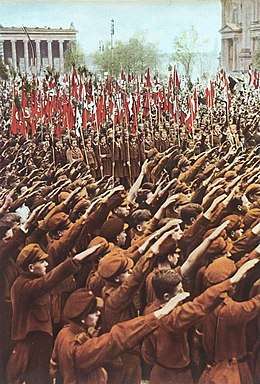
One reason the Hitler Youth so easily came into existence stems from the fact that numerous youth movements existed across Germany prior to and especially after World War I. These youth organisations were created for varying purposes; some were religious in disposition and others were ideological, but the more important among them were those formed for political reasons, like the "Young Conservatives" or the "Young Protestants".[4] Once Hitler came onto the revolutionary scene, the transition from seemingly innocuous youth movements to political entities focused on Hitler was swift.[5]
Following the abortive Beer Hall Putsch (in November 1923), the Nazi youth groups ostensibly disbanded, but many elements simply went underground, operating clandestinely in small units under assumed names. In April 1924, the Jugendbund der NSDAP was renamed Grossdeutsche Jugendbewegung (Greater German Youth Movement).[1] On 4 July 1926, the Grossdeutsche Jugendbewegung was officially renamed Hitler Jugend Bund der deutschen Arbeiterjugend (Hitler Youth League of German Worker Youth). This event took place a year after the Nazi Party itself had been reorganised. The architect of the re-organisation was Kurt Gruber, a law student from Plauen in Saxony.[6]
After a short power-struggle with a rival organisation—Gerhard Roßbach's Schilljugend—Gruber prevailed and his "Greater German Youth Movement" became the Nazi Party's official youth organisation. In July 1926, it was renamed Hitler-Jugend, Bund deutscher Arbeiterjugend ("Hitler Youth, League of German Worker Youth") and, for the first time, officially became an integral part of the SA. The name Hitler-Jugend was taken up on the suggestion of Hans Severus Ziegler.[7] By 1930, the Hitlerjugend (HJ) had enlisted over 25,000 boys aged 14 and upwards.[8][lower-alpha 1] They also set up a junior branch, the Deutsches Jungvolk (DJ), for boys aged 10 to 14. Girls from 10 to 18 were given their own parallel organisation, the League of German Girls (BDM).[10][11]
In April 1932, Chancellor Heinrich Brüning banned the Hitler Youth movement in an attempt to stop widespread political violence. But in June, Brüning's successor as Chancellor, Franz von Papen, lifted the ban as a way of appeasing Hitler, the rapidly ascending political star. A further significant expansion drive started in 1933, after Baldur von Schirach was appointed by Hitler as the first Reichsjugendführer (Reich Youth Leader).[12] All youth organizations were brought under Schirach's control.[3][13]
Doctrine
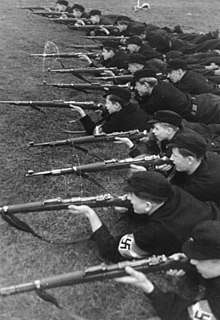
The members of the Hitler Youth were viewed as ensuring the future of Nazi Germany and were indoctrinated in Nazi ideology, including racism.[14] The Hitler Youth appropriated many of the activities of the Boy Scout movement (which was banned in 1935), including camping and hiking. However, over time it changed in content and intention. For example, many activities closely resembled military training, with weapons training, assault course circuits and basic tactics. The aim was to instill the motivation that would enable its members to fight faithfully for Nazi Germany as soldiers.[15] There was greater emphasis on physical fitness, hardness and military training than on academic study.[15][16] Sacrifice for the cause was inculcated into their training. Former Hitler Youth, Franz Jagemann claimed for instance that the notion "Germany must live" even if they (members of the HJ) had to die was "hammered" into them.[17]


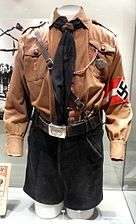
The Hitler Youth were used to break up Church youth groups, spy on religious classes and Bible studies,[18] and interfere with church attendance.[19][20] Education and training programs for the Hitler Youth were designed to undermine the values of the traditional elitist structures of German society along with their privileges; their training also aimed at an obliteration of social and intellectual distinctions between the classes, so as to be replaced and dominated by the political goals of Hitler's totalitarian dictatorship.[21] Besides promoting a doctrine of classlessness, additional training was provided that linked state-identified enemies such as Jews with Germany's previous defeat in the First World War, and societal decline.[22] As historian Richard Evans observes, "The songs they sang were Nazi songs. The books they read were Nazi books."[23]
Organisation
The Hitler Youth was organised into corps under adult leaders, and the general membership of the HJ consisted of boys aged fourteen to eighteen.[10] The Hitler Youth was organised into local cells on a community level. Such cells had weekly meetings at which various Nazi doctrines were taught by adult leaders. Regional leaders typically organised rallies and field exercises in which several dozen Hitler Youth cells would participate. The largest gathering usually took place annually, at Nuremberg, where members from all over Germany would converge for the annual Nazi Party rally.[24] Since the HJ and BDM were considered fully "Aryan" organizations by Nazi officials, premarital sex was encouraged in their ranks.[25][lower-alpha 2]
The Hitler Youth maintained training academies comparable to preparatory schools, which were designed to nurture future Nazi Party leaders.[27] The Hitler Youth also maintained several corps designed to develop future officers for the Wehrmacht (Armed Forces). The corps offered specialised foundational training for each of the specific arms for which the member was ultimately destined. The Marine Hitler Youth (Marine-HJ), for example, served as an auxiliary to the Kriegsmarine.[27] Another branch of the Hitler Youth was the Deutsche Arbeiter Jugend – HJ (German Worker Youth – HY). This organisation within the Hitler Youth was a training ground for future labor leaders and technicians. Its symbol was a rising sun with a swastika.[28] A program entitled Landjahr Lager (Country Service Camp) was designed to teach specifically chosen girls of the BDM high moral character standards within a rural educational setting.[29]
The Hitler Youth regularly issued the Wille und Macht (Will and Power) monthly magazine, edited by Baldur von Schirach.[lower-alpha 3] Other publications included Die Kameradschaft (Comradeship), which had a girl's version for the BDM called Mädelschaft, and a yearbook called Jungen eure Welt (Youth your World).[lower-alpha 4]
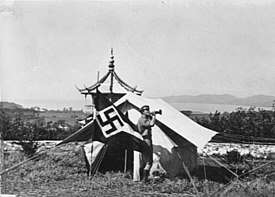
Membership
In 1923, the youth organisation of the Nazi Party had a little over 1,200 members.[30] In 1925, when the Nazi Party had been refounded, the membership grew to over 5,000.[30] Five years later, national membership stood at 26,000.[30] By the end of 1932, it was at 107,956.[31] The Nazis came to power in 1933, and the membership of Hitler Youth organisations increased dramatically to 2,300,000 members by the end of that year. Much of these increases came from forcible takeovers of other youth organisations. The sizeable Evangelische Jugend (Evangelical Youth), a Lutheran youth organisation of 600,000 members, was integrated on 18 February 1934.[32] In 1934, a law declared the Hitler Youth to be the only legally permitted youth organisation in Germany, and stated that "all of the German youth in the Reich is organised within the Hitler Youth".[33]
By December 1936, Hitler Youth membership had reached over five million.[34] That same month, membership became mandatory for "Aryans", under the Gesetz über die Hitlerjugend (Hitler Youth Law).[35] This legal obligation was reaffirmed in March 1939 with the Jugenddienstpflicht (Youth Service Duty), which conscripted all German youths into the Hitler Youth—even if the parents objected.[36] Parents who refused to allow their children to join were subject to an investigation by the authorities.[37] From then on, the vast majority of Germany's teenagers belonged to the Hitler Youth. By 1940, it had eight million members.[38]
Even before membership was made mandatory in 1939, German youth faced strong pressure to join. Students who held out were frequently assigned essays with titles such as "Why am I not in the Hitler Youth?"[39] They were also the subject of frequent taunts from teachers and fellow students, and could even be refused their diploma—which made it impossible to be admitted to university.[39] A number of employers refused to offer apprenticeships to anyone who was not a member of the Hitler Youth. By 1936, the Hitler Youth had a monopoly on all youth sports facilities in Germany, effectively locking out non-members. As time went on, a number of boys chafed under the regimented nature of the organisation; some even dropped out and only rejoined when they learned they could not get a job or enter university without being a member.[40] Effectively, the Hitler Youth constituted the single most successful of all the mass movements in the Third Reich.[41]
There were a few members of the Hitler Youth who privately disagreed with Nazi ideologies. For instance, Hans Scholl—the brother of Sophie Scholl and one of the leading figures of the anti-Nazi resistance movement Weiße Rose (White Rose)—was also a member of the Hitler Youth.[42][lower-alpha 5][lower-alpha 6]
World War II
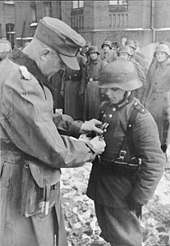
On 1 May 1940, Artur Axmann was appointed deputy to Schirach, whom he succeeded as Reichsjugendführer of the Hitler Youth on 8 August 1940.[43] Axmann began to reform the group into an auxiliary force which could perform war duties.[44] The Hitler Youth became active in German fire brigades and assisted with recovery efforts to German cities affected by Allied bombing. The Hitler Youth also assisted in such organisations as the Reich postal service, the Reich railroad services, and other government offices;[45] members of the HJ also aided the army and served with anti-aircraft defense crews.[46]
By 1943, Nazi leaders began turning the Hitler Youth into a military reserve to replace manpower which had been depleted due to tremendous military losses. The idea for a Waffen-SS division made up of Hitler Youth members was first proposed by Axmann to Reichsführer-SS Heinrich Himmler in early 1943.[47] The plan for a combat division made up of Hitler Youth members born in 1926 was passed on to Hitler for his approval. Hitler approved the plan in February and Gottlob Berger was tasked with recruiting.[47] Fritz Witt of SS Division Leibstandarte (LSSAH) was appointed divisional commander.[48]
In 1944, the 12th SS-Panzer-Division Hitlerjugend was deployed during the Battle of Normandy against the British and Canadian forces to the north of Caen. Over 20,000 German youths participated in the attempt to repulse the D-Day invasion;[49] while they knocked out some 28 Canadian tanks during their first effort, they ultimately lost 3,000 lives before the Normandy assault was complete.[50] During the following months, the division earned itself a reputation for ferocity and fanaticism. When Witt was killed by Allied naval gunfire, SS-Brigadeführer Kurt Meyer took over command and became the divisional commander at age 33.[51][lower-alpha 7]
As German casualties escalated with the combination of Operation Bagration and the Lvov-Sandomierz Operation in the east, and Operation Cobra in the west, members of the Hitlerjugend were recruited at ever younger ages. By 1945, the Volkssturm was commonly drafting 12-year-old Hitler Youth members into its ranks. During the Battle of Berlin, Axmann's Hitler Youth formed a major part of the last line of German defense, and were reportedly among the fiercest fighters. Although the city commander, General Helmuth Weidling, ordered Axmann to disband the Hitler Youth combat formations, in the confusion this order was never carried out. The remnants of the youth brigade took heavy casualties from the advancing Russian forces; only two survived.[52]
Post World War II

The Hitler Youth was disbanded by Allied authorities as part of the denazification process. Some Hitler Youth members were suspected of war crimes but, because they were children, no serious efforts were made to prosecute these claims. While the Hitler Youth was never declared a criminal organisation, its adult leadership was considered tainted for corrupting the minds of young Germans. Many adult leaders of the Hitler Youth were put on trial by Allied authorities, and Baldur von Schirach was sentenced to 20 years in prison.[53] However, he was convicted of crimes against humanity for his actions as Gauleiter of Vienna, not for his leadership of the Hitler Youth, because Artur Axmann had been serving as the functioning leader of the Hitler Youth from 1940 onward. Axmann only received a 39-month prison sentence in May 1949, but was not found guilty of war crimes.[54] Later, in 1958, a West Berlin court fined Axman 35,000 marks (approximately £3,000, or US$8,300), about half the value of his property in Berlin. The court found him guilty of indoctrinating German youth with National Socialism until the end of the war, but concluded he was not guilty of war crimes.[54]
German children born in the 1920s and 1930s became adults during the Cold War years. Since membership was compulsory after 1936, it was neither surprising nor uncommon that many senior leaders of both West and East Germany had been members of the Hitler Youth. Little effort was made to blacklist political figures who had been members, since many had little choice in the matter. These German post-war leaders were nonetheless once part of an important institutional element of Nazi Germany. Historian Gerhard Rempel opined that Nazi Germany itself was impossible to conceive without the Hitler Youth, as their members constituted the "social, political, and military resiliency of the Third Reich" and were part of "the incubator that maintained the political system by replenishing the ranks of the dominant party and preventing the growth of mass opposition."[55] Rempel also reports that a large percentage of the boys who served in the HJ slowly came to the realization that "they had worked and slaved for a criminal cause", which they carried for a lifetime; some of them recalled a "loss of freedom" and claimed their time in the HJ "had robbed them of a normal childhood."[56] Historian Michael Kater relates how many who once served in the HJ were silent until older age when they became grandparents, and while they were eventually able to look back at their place in "a dictatorship which oppressed, maimed, and killed millions", he maintains that an "honest" appraisal should lead them to conclude that their past contributions to the regime had "damaged their own souls."[57]
Once Nazi Germany was defeated by the Allied Powers, the Hitler Youth—like all NSDAP organisations—was officially abolished by the Allied Control Council on 10 October 1945[58] and later banned by the German Criminal Code.[lower-alpha 8]
Ranks and uniforms
Reichsjugendführer (Reich Youth Leader) was the highest rank of the Hitler Youth and was held by the Nazi Party official in command of the entire organization.[59] The rank of Reichsjugendführer was only held by two people during its existence, first by Baldur von Schirach and later by Artur Axmann.[60]
Members' summer uniform consisted of black shorts and tan shirt with pockets, worn with a rolled black neckerchief secured with a woggle, usually tucked under the collar.[61] Headgear originally consisted of a beret, but this was discarded by the HJ in 1934.[62] One flag/symbol used by the HJ was the same as the DJ, a white Sowilo rune on a black background, which symbolised "victory".[63] Another flag used was a red-white-red striped flag with a black swastika in the middle, inside a white shaped diamond. Full members would also receive a knife upon enrollment, with the motto "Blood and Honor" engraved upon it.[64]
| HJ Rank[65] | HJ insignia[66] | Translation | Heer equivalent | British equivalent[65] |
|---|---|---|---|---|
| Reichsjugendführer | ||||
| Reichsjugendführer | National Youth Leader | Generalfeldmarschall | Field Marshal | |
| Höheres Führerkorps | ||||
| Stabsführer | Staff Leader | Generaloberst | General | |
| Obergebietsführer | Senior Area Leader | General der Waffengattung | Lieutenant General | |
| Gebietsführer | Area Leader | Generalleutnant | Major General | |
| Hauptbannführer | Head Banner Leader | Generalmajor | Brigadier | |
| Führerkorps | ||||
| Oberbannführer | Senior Banner Leader | None | None | |
| Bannführer | Banner Leader | Oberst | Colonel | |
| Oberstammführer | Senior Unit Leader | Oberstleutnant | Lieutenant Colonel | |
| Stammführer | Unit Leader | Major | Major | |
| Höhere Führerschaft | ||||
| Hauptgefolgschaftsführer | Head Cadre Unit Leader | Hauptmann/Rittmeister | Captain | |
| Obergefolgschaftsführer | Senior Cadre Unit Leader | Oberleutnant | Lieutenant | |
| Gefolgschaftsführer | Cadre Unit Leader | Leutnant | Second Lieutenant | |
| Führerschaft | ||||
| Oberscharführer | Senior Squad Leader | Oberfeldwebel | Sergeant Major | |
| Scharführer | Squad Leader | Feldwebel | Staff Sergeant | |
| Oberkameradschaftsführer | Senior Comrade Unit Leader | Unterfeldwebel | Sergeant | |
| Kameradschaftsführer | Comrade Unit Leader | Unteroffizier | Corporal | |
| Oberrottenführer | Senior Section Leader | Obergefreiter | Lance Corporal | |
| Rottenführer | Section Leader | Gefreiter | None | |
| Hitlerjungen | ||||
| Hitlerjunge | Hitler Youth | Soldat | Private | |
| Source: [lower-alpha 9] | ||||
Troop colours:[66] [lower-alpha 10]
- Carmine (karmesinrot): Area and Reichsjugendführer staffs
- Scarlet (hochrot): GeneralHJ
- Light blue (hellblau): Flyer-HJ (Flieger-HJ)
- Pink (rosa): Motor HJ (Motor-HJ)
- Yellow (gelb): Communications-HJ (Nachrichten-HJ)
- Green (grün): HJ-agricultur service (HJ-Landdienst)
- White (weiß):
- NSDAP educational institutions
- HJ-Patrol service (1943): (Hj-Streifendienst)
- Navy-HJ (Marine-HJ)
- Mounted-HJ: (Reiter-HJ)
- HJ-mountain walk grups (HJ-Bergfahrtengruppen)
- HJ-fire brigade units: (HJ-Ferwehrscharen)
- HJ-fiel surgeon: (HJ-Feldschere)
- BDM-health service girl (BDM-Gesundheitsdienstmädel)
- Mountain-HJ: (Gebirgsjäger-HJ)
See also
- Jojo Rabbit – satire film about Hitler Youth
- National Socialist German Students' League
- National Socialist Schoolchildren's League
- Nationale Jeugdstorm - Dutch Fascist youth movement
- Opera Nazionale Balilla – Italian Fascist youth movement
- Vorwärts! Vorwärts! – Anthem of Hitler Youth
References
Informational notes
- Historian Richard Evans reported an even lower number of only 18,000 members of the HJ in 1930.[9]
- At the 1936 Nuremberg Rally, where there were some 100,000 participants of the HJ and Girls' League present, upwards of 900 girls between fifteen and eighteen years of age returned home pregnant.[26]
- "Wille und Macht." germaniainternational.com. Retrieved: 1 February 2010.
- "Other HJ publications." germaniainternational.com. Retrieved: 1 February 2010.
- This fact is emphasised in the film The White Rose which depicts how Scholl was able to resist Nazi Germany's ideology while being a member of the Nazi Party's youth movement.
- The 1993 Thomas Carter film Swing Kids also focuses on this topic.
- Meyer was later sentenced to death by a Canadian court after his capture for ordering the HJ to shoot 64 British and Canadian POWs (making them complicit in a war crime).[50]
- The Hitler Youth and their related symbology was connoted as unconstitutional in the German Criminal Code (Strafgesetzbuch) (StGB): § 86 StGB: Verbreiten von Propagandamitteln verfassungswidriger Organisationen (Dissemination of Propaganda Material of Unconstitutional Organizations) and by § 86a StGB: Verwenden von Kennzeichen verfassungswidriger Organisationen (Use of Signs of Unconstitutional Organisations). See: http://www.lawww.de/Library/stgb/86.htm or https://www.bundestag.de/blob/195550/4db1151061f691ac9a8be2d9b60210ac/das_strafbare_verwenden_von_kennzeichen_verfassungswidriger_organisationen-data.pdf
- To verify these ranks, see the Nazi publication: Reichsorganisationsleiter der NSDAP (1943). Organisationshandbuch der NSDAP. München: Zentralverlag der NSDAP, Franz Eher Nachf., Tafels 55,56, and p. 458.
- See: Reichsorganisationsleiter der NSDAP (1943), p. 460/461-462.
Citations
- Lepage 2008, p. 21.
- Mühlberger 2004, pp. 30–32.
- Zentner & Bedürftig 1991, p. 431.
- Koch 1996, p. 40.
- Koch 1996, pp. 40–41.
- Lepage 2008, pp. 21–23.
- Klee 2005, p. 694.
- Stachura 1975, pp. 114–115.
- Evans 2006, p. 271.
- Zentner & Bedürftig 1991, pp. 431, 434.
- Kater 2004, p. 16.
- Zentner & Bedürftig 1991, pp. 431, 835.
- Kater 2004, pp. 48–59.
- Zentner & Bedürftig 1991, pp. 432–435.
- Zentner & Bedürftig 1991, pp. 434–435.
- Evans 2006, p. 273.
- Rees 2012, p. 135.
- Bonney 2009, p. 139.
- Koch 1996, p. 220.
- Rempel 1989, p. 102.
- Hildebrand 1984, p. 45.
- Kater 2004, pp. 62–69.
- Evans 2006, p. 274.
- Koch 1996, pp. 63, 68, 72, 105.
- Mühlhäuser 2014, p. 170.
- Grunberger 1971, p. 280.
- McNab 2009, p. 155.
- Littlejohn 1988, p. 55.
- Shirer 1990, pp. 254–255.
- Rempel 1989, p. 266.
- Koch 1996, p. 89.
- Priepke 1960, pp. 187–189.
- Shirer 1990, p. 253.
- Rempel 1989, p. 268.
- Stachura 1998, p. 478.
- Müller 1943, pp. 87–89.
- United States Holocaust Memorial Museum 2007, p. 35.
- Stachura 1998, p. 479.
- Evans 2006, p. 272.
- Fulbrook 2011, pp. 140–142.
- Williamson 2002, p. 55.
- Kater 2004, pp. 122–123.
- Hamilton 1984, p. 247.
- Stein 1984, pp. 205–206.
- Rempel 1989, p. 68.
- Dear & Foot 1995, p. 425.
- McNab 2013, p. 295.
- Stein 1984, p. 205.
- Bartoletti 2005, p. 133.
- Kater 2004, p. 214.
- Forty 2004, p. 29.
- Butler 1986, p. 172.
- Rempel 1989, pp. 250–251.
- Hamilton 1984, p. 248.
- Rempel 1989, p. 2.
- Rempel 1989, p. 252.
- Kater 2004, p. 265.
- Cogen 2012, p. 226.
- McNab 2009, p. 15.
- Hamilton 1984, pp. 247, 334.
- Stephens 1973, p. 43.
- Stephens 1973, p. 8.
- Stephens 1973, p. 73.
- Wilson 2012, p. 74.
- CIA 1999, p. 21.
- Verlag Moritz Ruhl 1936, Table 20.
Bibliography
- Bartoletti, Susan Campbell (2005). Hitler Youth: Growing Up in Hitler's Shadow. New York: Scholastic Nonfiction. ISBN 9780439353793.CS1 maint: ref=harv (link)
- Bonney, Richard, ed. (2009). Confronting the Nazi War on Christianity: The Kulturkampf Newsletters, 1936–1939. Bern: Peter Lang. ISBN 978-3-03911-904-2.CS1 maint: ref=harv (link)
- Butler, Rupert (1986). Hitler's Young Tigers: The Chilling True Story of the Hitler Youth. London: Arrow Books. ISBN 0-09-942450-9.CS1 maint: ref=harv (link)
- CIA (24 August 1999). "Records Integration Title Book" (PDF). Retrieved 11 December 2018.CS1 maint: ref=harv (link)
- Cogen, Marc (2012). Democracies and the Shock of War: The Law as a Battlefield. London and New York: Routledge. ISBN 978-1-40944-363-6.CS1 maint: ref=harv (link)
- Dear, Ian; Foot, M.R.D., eds. (1995). The Oxford Guide to World War II. Oxford; New York: Oxford University Press. ISBN 978-0-19-534096-9.CS1 maint: ref=harv (link)
- Evans, Richard (2006). The Third Reich in Power. New York: Penguin. ISBN 978-0-14303-790-3.CS1 maint: ref=harv (link)
- Forty, George (2004). Villers Bocage. Battle Zone Normandy. Sutton Publishing. ISBN 0-7509-3012-8.CS1 maint: ref=harv (link)
- Fulbrook, Mary (2011). Dissonant Lives: Generations and Violence Through the German Dictatorships. Oxford; New York: Oxford University Press. ISBN 978-0199287208.CS1 maint: ref=harv (link)
- Grunberger, Richard (1971). The 12-Year Reich: A Social History of Nazi Germany, 1933–1945. New York: Henry Holt & Co. ISBN 0-03-076435-1.CS1 maint: ref=harv (link)
- Hamilton, Charles (1984). Leaders & Personalities of the Third Reich, Vol. 1. R. James Bender Publishing. ISBN 0-912138-27-0.CS1 maint: ref=harv (link)
- Hildebrand, Klaus (1984). The Third Reich. London and New York: Routledge. ISBN 0-0494-3033-5.CS1 maint: ref=harv (link)
- Kater, Michael H. (2004). Hitler Youth. Cambridge, MA: Harvard University Press. ISBN 0-674-01496-0.CS1 maint: ref=harv (link)
- Klee, Ernst (2005). Das Personenlexikon zum Dritten Reich. Wer war was vor und nach 1945 (in German). Frankfurt am Main: Fischer Taschenbuch Verlag. ISBN 978-3-59616-048-8.CS1 maint: ref=harv (link)
- Koch, H. W. (1996). The Hitler Youth: Origins and Development, 1922–1945. New York: Barnes and Noble. ISBN 978-0880292368.CS1 maint: ref=harv (link)
- Lepage, Jean-Denis G.G. (2008). Hitler Youth, 1922–1945: An Illustrated History. Jefferson, NC; London: McFarland & Co. ISBN 978-0786439355.CS1 maint: ref=harv (link)
- Littlejohn, David (1988). The Hitler Youth. Somerset, KY: Agincourt. ISBN 0-934870-21-7.CS1 maint: ref=harv (link)
- McNab, Chris (2009). The Third Reich. Amber Books Ltd. ISBN 978-1-906626-51-8.CS1 maint: ref=harv (link)
- McNab, Chris (2013). Hitler's Elite: The SS 1939–45. Osprey. ISBN 978-1-78200-088-4.CS1 maint: ref=harv (link)
- Mühlberger, Detlef (2004). Hitler's Voice: The Völkischer Beobachter, 1920–1933. Vol. 1 [Organisation & Development of the Nazi Party]. Bern: Peter Lang. ISBN 978-3906769721.CS1 maint: ref=harv (link)
- Mühlhäuser, Regina (2014). "A Question of Honor: Some Remarks on the Sexual Habits of German Soldiers during World War II". In Wolfgang Bialas; Lothar Fritze (eds.). Nazi Ideology and Ethics. Newcastle upon Tyne: Cambridge Scholars. ISBN 978-1-44385-422-1.CS1 maint: ref=harv (link)
- Müller, Albert (1943). Die Betreuung der Jugend: Überblick über eine Aufgabe der Volksgemeinschaft (in German). Berlin: Eher Verlag.CS1 maint: ref=harv (link)
- Priepke, Manfred (1960). Die evangelische Jugend im Dritten Reich 1933–1936 (in German). Frankfurt: Norddeutsche Verlagsanstalt.CS1 maint: ref=harv (link)
- Rees, Laurence (2012). Hitler’s Charisma: Leading Millions into the Abyss. New York: Vintage Books. ISBN 978-0-30738-958-9.CS1 maint: ref=harv (link)
- Rempel, Gerhard (1989). Hitler's Children: The Hitler Youth and the SS. Chapel Hill, NC: University of North Carolina Press. ISBN 978-0-8078-4299-7.CS1 maint: ref=harv (link)
- Shirer, William (1990). The Rise and Fall of the Third Reich. New York: MJF Books. ISBN 978-1-56731-163-1.CS1 maint: ref=harv (link)
- Stachura, Peter D. (1975). Nazi Youth in the Weimar Republic. Santa Barbara, CA: Clio Books. ISBN 978-0-87436-199-5.CS1 maint: ref=harv (link)
- Stachura, Peter D. (1998). "Hitler Youth". In Dieter Buse; Juergen Doerr (eds.). Modern Germany: An Encyclopedia of History, People, and Culture 1871–1990. 2 Vols. New York: Garland Publishing. ISBN 978-0-81530-503-3.CS1 maint: ref=harv (link)
- Stein, George H. (1984). The Waffen SS: Hitler's Elite Guard at War, 1939–1945. Ithaca, NY: Cornell University Press. ISBN 0-8014-9275-0.CS1 maint: ref=harv (link)
- Stephens, Frederick John (1973). Hitler Youth: History, Organisation, Uniforms and Insignia. Alnark Publishing. ISBN 0855241047.CS1 maint: ref=harv (link)
- United States Holocaust Memorial Museum (2007). Nazi Ideology and the Holocaust. Washington DC: United States Holocaust Memorial Museum. ISBN 978-0-89604-712-9.CS1 maint: ref=harv (link)
- Verlag Moritz Ruhl (1936). Deutche Uniformen (in German). Leipzig: Verlag Moritz Ruhl.CS1 maint: ref=harv (link)
- Williamson, David (2002). The Third Reich. London: Longman Publishers. ISBN 978-0-58236-883-5.CS1 maint: ref=harv (link)
- Wilson, A.N. (2012). Hitler. New York: Basic Books. ISBN 978-0-46503-128-3.CS1 maint: ref=harv (link)
- Zentner, Christian; Bedürftig, Friedemann (1991). The Encyclopedia of the Third Reich. (2 vols.) New York: Macmillan Publishing. ISBN 0-02-897500-6.CS1 maint: location (link) CS1 maint: ref=harv (link)
External links
| Wikimedia Commons has media related to Hitlerjugend. |
- Neville Chamberlain writes to the Hitler Youth on archive.org